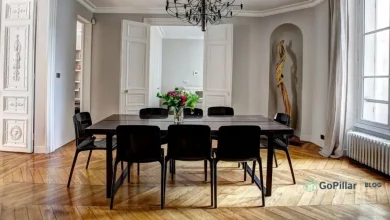Versatile and capable of making any environment unique, wallpapers have now become a must-have in the world of interior design.
Thanks to the use of wallpapers, every room has the possibility to be characterized in a unique and creative way, through different solutions and materials that make this type of wall covering suitable for both the living room and the bedroom, making it versatile even for the bathroom and kitchen.
Table of Contents
Wallpaper: 4 examples for your home
The world of wallpapers is very wide and includes different types of installation and materials. They can have a single or two layers, one of which is a backing, and have an average life of about 10/12 years.
Here are 4 examples of wallpaper and their characteristics:
-
Paper wallpaper

This is the most traditional type, on which it is possible to obtain all kinds of prints with an excellent aesthetic result. They are characterized by being of a single layer, which can have different thicknesses, and are made of cellulose, so they are not suitable for humid environments.
-
Vinyl wallpaper

Surely the most versatile and resistant type. In fact, these wallpapers are composed of two layers, a first one in paper or tnt and a subsequent coating in plastic material capable of offering all kinds of effects, smooth, rough or three-dimensional finishes.
-
Natural fiber wallpaper

This type includes different materials of natural origin, such as cotton, linen, silk, leather, jute or cork and can be made with different laying systems. The characteristics of natural or vegetable fibers make the textures of these coverings truly unique and often very valuable.
Among the materials belonging to this category we recall in particular rice paper, which lends itself to be decorated with different techniques, including various types of hand painting, making these coatings extremely customizable.
-
Fiberglass wallpaper

In this case, this is a very practical solution since this type is characterized by a high mechanical resistance. It also offers endless decorative possibilities as it is printable and, being water-repellent, it is also suitable for application in humid environments such as the bathroom.
How to choose the right wallpaper for your home
Suitable for any style, wallpapers can become an important decorative element in the home. In fact, they can cover entire walls or parts to enhance, even giving a touch of originality by applying them also on the ceiling.
The world of wallpapers, however, as we know, is really wide, there are many colors, patterns and finishes, so the choice can be complicated. Here are some tips on how to choose which one to use and how to use it.
Some tricks
First of all, it is always good to take into account the color palette of our home or the environment on which we want to intervene and therefore seek a solution that, by affinity or contrast, is best suited to the whole and the style of our home.
We will also need to understand what wallpaper we want to give to the wall to be coated, remembering that wallpaper can help us to focus attention on a particular point. This could also be a little trick to try to draw the eye away from the areas we want to hide.
You use them according to the environments
As for the bedroom, for example, the best option is to cover the wall behind the head of the bed, preferably with soft, light colors.
In the living room, on the other hand, the ideas could be many, you could choose to drape one of the walls, perhaps behind the sofa, or behind a bookshelf or even create small portions of drapery to focus attention on specific points.
Even the passage areas can be given new life thanks to the use of wallpaper, in this case an idea could be to apply them on the ceiling or in a part where there are pictures, to add a touch of originality in spaces often poorly characterized.
As for the bathroom, it is certainly good to take into account the typology, choosing a wallpaper suitable for humid environments and choosing a pattern that best suits the atmosphere we want to create. Also in this case we could choose to completely cover the bathroom, thus also replacing the tiles, or apply the coating only in some points, perhaps behind the mirror above the sink or in the shower.






